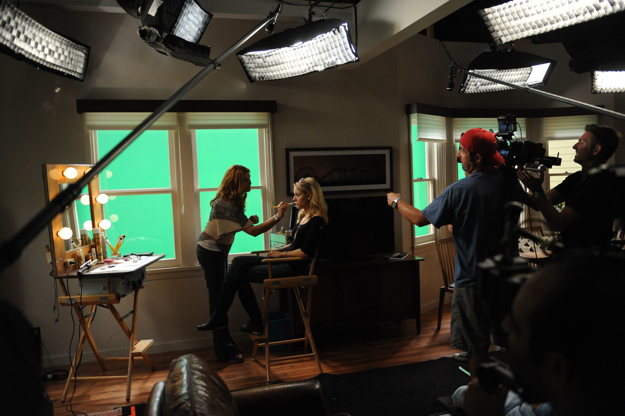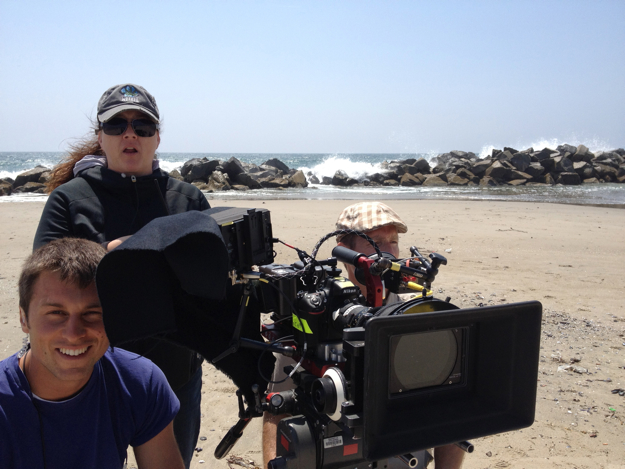
There is the cliché that there’s a bit of magic that goes into filmmaking. In Bradford Lipson’s case, it truly was magic that landed him in the business. Like many children, Lipson was fascinated by the slight of hand, but whereas most kids would eventually grow tired of pulling a card, any card out of a deck, Lipson continued to study the craft, where he realized there is a connection between magic and film. Naturally, a career in filmmaking soon followed, starting out as a gaffer doing lighting work.

Fast-forward to present day, Lipson, 52, is a Denver-born cinematographer based in Los Angeles. His current project is “Wilfred,” a black comedy starring Elijah Wood as a depressed young man named Ryan who sees his neighbor’s dog (portrayed by series co-creator Jason Gann) as a man wearing a dog suit. (The critically praised show on FX was adapted from the original Australian series, also co-created by Gann.) What’s unique about this eccentric “man’s best friend” series is that it is shot entirely with a DSLR camera.
We caught up with Lipson to talk a bit more about his career, why the “Wilfred” production crew uses a DSLR (and how the use of it has affected the industry, in general), and teaches us how we to put some of that magic into our home movies.
You’ve been in the filmmaking business for 30 years. What first drew you to it?
When I was a kid I was really into magic. I actually was making money as a magician at the age of 13. I was also studying stage magic, which relies on many optical illusions. I had somehow made a correlation between magic, movies, and photography. To me film is magical, just the chemical process that occurs when exposing film seemed like an amazing magic trick. Movies are merely an optical illusion: individual still images running through a projector at 24 frames per second, creating the illusion of movement.
During high school I took an intense film class taught by a retired documentary filmmaker; we were shooting 16mm all the time. I realized I had a passion for creating images and working with cameras. I began to understand just how important lighting is when it comes to the quality and emotion of an image and decided I wanted to become a director of photography (DP).
In your words, what is the role of the DP? Every DP has his/her own style – describe yours.
To me, a DP’s role is to help create the director’s vision in order to tell the story. It’s my job to facilitate getting the right shots and getting what the director wants. It’s also my job to bring ideas to the table. The DP’s job is also to suggest ways to adjust blocking [deciding where the actors will be on set and the first camera position] to save setups and, therefore, time. On a TV series the DP keeps the look and tone of the show consistent, as various directors come to direct. And, of course, the DP’s job is to create the look of project, which is a combination of many technical choices along with the knowledge and creativity to light the frame.
I can’t say I have a particular style – each show demands a different look. I wouldn’t want to use the same look on every single project. However, the style in which I like to work is consistent from show to show: Respect the director’s vision, treat the crew with great respect, and work in excellence every day.
How did you end up on the set of “Wilfred?”
I met Randall Einhorn (executive producer and director of “Wilfred”) when he was working as the DP on “The Office.” He hired me as his gaffer. As the first few seasons rolled by he was directing more and more. Simultaneously, I was working toward full-time DP work; I left “The Office” to shoot a little show that got me into Local 600 as a DP. Randall and I kept in touch and from time to time he would be directing an episode of a show I was working on.
One day I got a phone call from him, asking if I would please come work on reshoots of a pilot he did, called “Wilfred.” He sent me the cut and I had to watch it more than once – it was so crazy funny, dark, creative, and way out there. I did the reshoots, but, technically, I was the gaffer and Randall was the DP, (but) he was so busy with directing I took it upon myself to work more in the capacity of the DP. About a month later Randall called me and told me the show had been picked up. He had liked the way the reshoots went and looked, so he offered me the opportunity to DP the show.
What initially drew me to the project was the opportunity to shoot a very interesting and visually compelling comedy like no other. The subject matter was too good to pass up. I saw great potential with this show: The opportunity to work with Randall, who is an incredibly talented director; David Zuckerman, who is a brilliant writer; and Jason Gann, Elijah Wood, and the rest of the cast was an opportunity I couldn’t turn down.

Compared to other works you have done, is there anything unique about “Wilfred,” in terms of how the crew approaches the material?
First off, Randall had a vision for the show during the pilot (which I didn’t shoot). He chose to shoot on DSLRs as a means of getting the large, full-frame sensor and wide-open aperture to create that amazing shallow depth of field. It is the main reason why the show isn’t shot on a traditional production camera. That has been an important element to the look of the show and the way the relationship between Ryan and Wilfred is portrayed, since its inception.
We shoot three cameras simultaneously. Most single camera shows use two cameras: one will get the master and the other will get a medium shot or another angle if possible. We use three cameras to get the master and coverage from both sides at the same time, which can be very difficult. One thing that I have tried to do since day one is to always light the off-camera side, which is often challenging with the three-camera setup.
Another way I like to light is to have a hot down-light bounce off a surface that is in the shot, illuminating Ryan and Wilfred – you will see this often in the basement in night scenes. It creates such an interesting look and it’s something we can get away with on this show. I don’t ever try to force backlights – I work to create separation with color, light and shadows or practicals in the background.
You shoot “Wilfred” entirely with the Nikon D800. Why this camera in particular?
When we got word of what the D800 had to offer, Randall and I were very interested in trying it out. The fact that we can access an uncompressed HD signal through the HDMI-out is a fantastic help; also, the ability to go from a FX frame size to DX [big to small] is advantageous for our show. What I came to learn is just how sensitive the sensor is. It performs wonderfully in the shadows and blacks. I also like how there is not a native ISO so I don’t get forced into staying at particular ISO increments. When I got into color timing I found the colors to be rich and I was pleased at how the camera handled the mixture of color temps that I use.
How has DSLR filmmaking changed the industry? What are the pros and cons?
DSLRs are showing up on TV series production sets more and more. They usually aren’t the workhorse cameras, but it’s the camera to use in tight quarters and to get the difficult, odd placement type of shot. It takes much less “rigging” time than if you were using a larger production camera, and time equals money. I also see the camera enabling more young filmmakers to go out and shoot their film at a quality that, before, was never accessible or possible at such a low cost. The con: It seems like it’s hard to find the one rig that supports DSLRs perfectly. There are so many choices, some good, some not so good. Also, viewfinders: When there are camera operators coming off of a show with high-end viewfinders, it’s hard for them to adjust to the ones typically used with these cameras. I’m hopeful there is some new technology in this area on the horizon.

More and more cameras now have Full HD 1080p recording. For the general user who would like to dabble in videography with their DSLR or point-and-shoot, what are a few tips you can offer to get started or to improve their shoots?
The first thing is to have fun with it and not get caught up with worrying about right or wrong. If what you are doing works for you, then keep doing it – if it doesn’t work, experiment with something else. Learn what the latitude and exposure limitations are with the camera being used – once you get this you can stay within the ratios and create pleasing images.
Another big thing is to not get into the game of thinking it’s all about the gear – it’s what you do with what you have. Some of the best creative moments occur because you don’t have a particular piece of gear, so you are forced to think outside the box and create something you might not have otherwise. Be aware and observe how light is working in various environments and how it looks on people; when you see something you like, memorize it so you can recreate it when you are shooting.
Back in the old days when you shot something on film, you had to wait and see how it came out. Now it’s instant playback and the ability to make adjustments (whenever) you want, so be bold – the worst thing that (could happen) is you erase the file and start over.
Want to get into DSLR videography? Lipson explains how
- It would be worthwhile investing in some lighting classes if you are new to this.
- There are so many rigs you can purchase to make the DSLR a production camera you really have to do your homework. It would be wise to decide the style you will be shooting – by this I mean handheld or on a dolly or sticks and a head (tripod). If it’s all of the above, then the rig will have to be flexible and give you all those capabilities.
- A good viewfinder and/or monitor are lifesavers. A good solid focusing system that is consistently reliable will save you lots of frustration, as well. A lighting kit that allows you to shoot day and night interiors, and can be used as hard light sources and soft light sources are important. Also, a good gel selection and a good understanding of Kelvin temperature in relationship to white balance will help give you dynamic images.
- (One product) that I find very flexible and pleasing with lighting and that is the FJ Westcott TD5 fixtures with their 12 x 50-inch soft box. These are incredibly flexible and easy to work with.
- Lastly, a DSLR that will give you the most dynamic range and most pleasing images.


